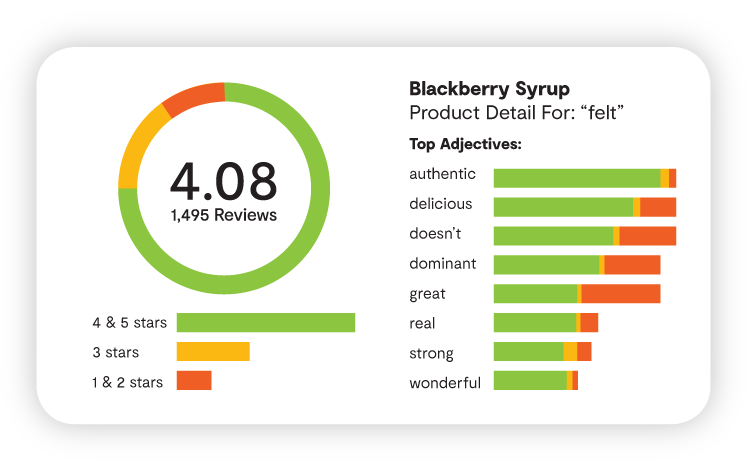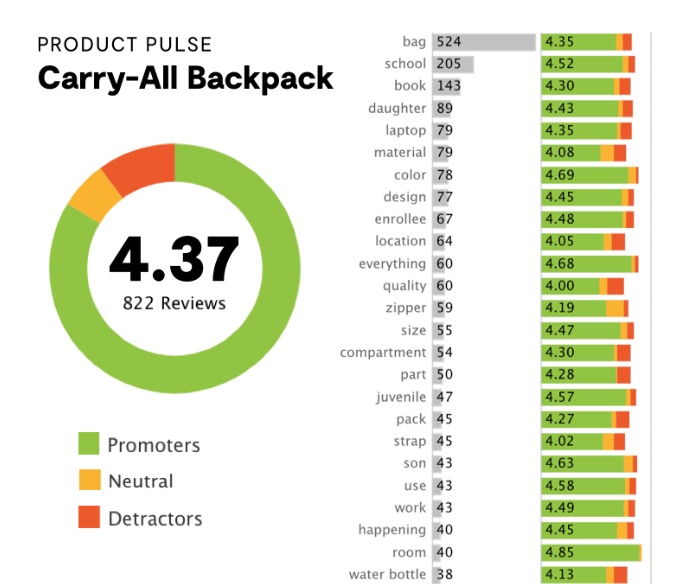You can’t have a retail business without a good product to sell, which is why companies invest enormous resources into a thoughtful product development strategy.
The most successful retailers understand the importance of developing new products and improving their existing merchandise. Continuously finding ways to innovate will keep your business competitive.
Not sure where to start?
This post will walk you through the seven stages of an ecommerce product development strategy. By the end of this article, you’ll have a solid idea of how winning products make it to the market—and how you can create more of them.
1. Smarter Product Ideation
Every great product starts with an idea. It happens when you and your team get that light bulb moment and come up with a concept that would change the world—or at least, add value to other people’s lives.
There are multiple ways to navigate the ideation process, but one of the most popular and effective methods is to start with by gathering customer feedback from your existing shoppers. Conduct surveys and analyze your product reviews to identify pain points and opportunities to improve.
Let’s say you discovered that a significant chunk of your customers are asking if an item comes in another color or size. You now have valuable feedback that you can use when developing your next product line.

Pro tip: Want to make this process easier? Instead of manually combing through your reviews, use a review analytics solution like Product Pulse, which uses natural language processing and sentiment analysis to uncover trends and insights that you can use in your product development strategy. Powered by our Intelligence Engine, the solution has processed over 40 million product reviews, 2 million unique topics and 5 million unique opinions.
Learn more about Product Pulse and see a demo by contacting our team today!
Learn the S.C.A.M.P.E.R. Technique
In addition to analyzing reviews, you should also consider the SCAMPER technique when cooking up product ideas. SCAMPER stands for Substitute, Combine, Adapt, Modify, Put to another use, Eliminate and Reverse/Rearrange.
It’s a way of thinking that prompts you to ask questions about how you can innovate and improve an existing product.
- Substitute – Think about a product and ask yourself if you can substitute any of its materials or parts. For instance, if you’re selling brownies and want to make them healthier, you could use other ingredients to replace things like sugar or butter.
- Combine – Find two or more things that your customers love and combine them. A great example of this can be found in the Doritos Locos Taco, Taco Bell’s most popular menu item, which combined the restaurant’s famous tacos with Doritos.
- Adapt – You could enhance a product so it adapts to modern changes. For instance, when more people started using their camera phones to take selfies, smartphone companies adapted to consumer behavior by developing front-facing cameras.
- Modify – The “M” can also stand for “Minify” or “Magnify.” It prompts you to think of ways to modify an existing product by highlighting or reducing specific features. A fashion designer could modify existing work by making dress buttons larger or by shortening overall length.
- Put to another use – Can you use the product (or the technology behind it) for another purpose? An increasing number of retailers, for instance, are upcycling old clothes and materials to create new ones.
- Eliminate – How can you simplify the product? Are there features that you can eliminate? We can see this in action in the latest Apple products, which contain fewer ports. Take the latest Macbook Air, which no longer has USB ports.
- Reverse/Rearrange – Can you interchange or reverse the components of a product? For instance, a shoe designer can move the brand’s logo around to see if it would make a bigger impact on the design.
2. Determining Product Demand
Already have a product idea that you love? Great. The next phase is to determine if there is a demand for it. The last thing you want is to go into full-on production mode only to realize that people don’t want it.
https://www.instagram.com/p/B2pOjANgTHN/?utm_source=ig_web_copy_link
So, take some time to assess just how much your market wants or needs your product. You can do this by:
Conducting Customer Surveys
One of the easiest ways to determine whether or not people like your idea is to ask them. Conduct a survey or speak directly to your most engaged customers to run the idea by them. Ask them what they think, why they like or dislike the concept and how much they would be willing to pay for the item.
The answers to these questions will tell you if your idea is a winner or a dud.
Take Pre-Orders
You can take things a step further and see if you can get people to place pre-orders for the product. Set up a product page for your concept—complete with a product description, photos and a CTA to buy.
Preorder your Steve Irwin Pop! Vinyl now before all the meerkats get them!https://t.co/RGLoz0Z5Is pic.twitter.com/oyYSHVtiay
— Terri Irwin (@TerriIrwin) September 19, 2019
If you get enough pre-orders you can take that as a sign to move forward with production.
Start A Crowdfunding Campaign
Another route is to crowdfund your idea. Use a platform like Kickstarter or Indiegogo to set up a campaign explaining your idea and mapping out your plan. If you get enough people to back your campaign, you might just have a winner on your hands.
Analyze Search Trends
Use tools such as Google Keyword Planner and Google Trends to find out if people searching for the type of product you want to develop or if they’re looking for a solution that your idea can solve.
3. Creating a Prototype
The next step is prototyping.
Prototypes are essential in any product development strategy because they enable you to test the design and functionality of your concept. After all, an idea may seem possible in theory, but you won’t find out for sure until you have a physical representation of the product.
The specifics of this stage will vary from one product to the next, but here’s what’s typically involved in the prototyping process:
Sketching the Idea
It’s one thing to have an idea in your head, but bringing it to reality requires solidifying the concept on paper. Create a sketch of your idea so you and your team can better visualize what the prototype would look like. The sketch should communicate general details like the major components of the item and what the product will be used for.
Creating a Digital Prototype
Once you’ve nailed the sketch, you can proceed to create a digital prototype. This would be a 3-D rendering of the product that allows you to view it from multiple angles. Having a digital prototype will enable you to see the item in more detail, so you can refine it before creating the physical version.
Building a Physical Prototype
When you’re happy with the digital version of your product, you can move forward with your physical prototype. Get help from an engineer or prototype designer to create one that you can touch, feel and evaluate.
Note that you can build multiple prototypes for each of your ideas. It’s actually recommended that you do this, as it enables you to compare and test different variations to see what works best.
Take Spanx, as an example. When the brand developed the strap for its Bra-llelujah! Bra, Spanx tested hundreds of prototypes and construction trials to determine the best one.
https://www.facebook.com/SPANX/posts/10161866114905188
4. Testing & Validation
Got your working prototypes? Test them out on your target customers and gather feedback. The key here is to find your actual customers and let them try the product themselves.
Using Spanx as an example, founder Sara Blakely said that during the prototyping phase of her first product, she was “blown away” by how the production mill tested the prototype.
As she recalled in her presentation at Inc Live:
They had these plastic forms in their mill, and they would put the product up on the plastic form and they’d all stand back with their clipboards and go, “Yep, that’s a medium.” I remember I leaned in, I’m like, “Ask her how she feels.”
Sara took a different approach. Rather than testing her prototypes on lifeless forms, she asked actual women to try her product.
“So, with Spanx, I started testing my prototypes on real women, my mom, my grandmother, all my friends,” she added in the video. “And to this day, all of the Spanx products are obviously tested and worn by me and all of my friends and family and I really appreciate that honest feedback, it’s what makes us better than what had existed out there.”
Follow Blakely’s playbook when testing your prototypes. Find real consumers to test them out and strive to get their honest feedback on how to improve.
5. Don’t Forget Your Product Creation
Once you’ve perfected your prototype, you can move on to production. Again, the specifics of this phase will depend on the product—the materials, complexity, etc. But generally speaking, one of the most important parts of the product creation process is selecting your manufacturer.
There are several websites and directories that you can use to find the right one. Here are a few that you can start with:
You can also check out trade publications and directories in your industry to find potential manufacturers.
Use the above resources to search and identify companies that can bring your product to life. Once you have a list of manufacturers, contact them to discuss:
- Payment terms
- Turnaround time
- Minimum order sizes
- Their facilities and production environment
- What happens in the event of delays and special circumstances
Also, consider asking for examples of similar products that they’ve manufactured. References from companies in your space are also beneficial.
6. Launching the Product on the Right Foot
The key to a good product launch is to do it explosively. When your product goes live, you want to make a strong and memorable impression on your target market, so they’ll be compelled to check out it out.
Accomplishing this requires a well-coordinated marketing push. You should ensure that all your marketing initiatives (e.g., email marketing, Facebook ads, paid search ads, influencers, etc.) are in sync. Doing so maximizes the impact and visibility of your product.
Certain book authors are particularly good at this. Consider Marie Forleo, when she launched her book, Everything Is Figureoutable, Forleo had a well-timed and well-coordinated marketing campaign that covered multiple channels.
She drummed excitement on social media, leveraged email marketing, kicked off a live event and went on the TODAY Show to talk about her book.
https://www.instagram.com/p/B2O-Cr2gZJR/
Forleo made a huge splash on the day of her launch, which led to multiple online reviews, numerous mentions on social media and sold out book tour events in multiple cities.
Strive to market your new products in the same way. Create an explosive launch by leveraging various marketing tools and maximizing your impact on multiple channels.
7. Gathering Feedback (Hint: Look to Your Product Reviews)
Your product development strategy doesn’t end with a launch. You need to close the loop by gathering feedback from your customers. You can do this by:
Analyzing Product Ratings & Reviews
The product reviews section of your site is your most valuable source of feedback. Pay close attention to what people are saying about the item, the star rating that they’re giving the product and any common trends or themes that come up.
The insights that you gather at this stage will be incredibly useful when you decide to create a new product or improve an existing one.

For best results, automate this process using a tool like Product Pulse, which analyzes product review data for you and delivers actionable insights that you can put to good use.
Engaging in Social Listening
If you have an active social media presence, then sites like Facebook, Instagram and Twitter can be valuable sources of feedback. Look at what people are saying on these sites and take note of the photos that they’re posting. Social media content offer insights into how people are using the product and how it fits into their lives.
Listening to Your Customers Is a Must in Any Product Development Strategy
Product development magic can’t happen in a vacuum. Amazing ideas aren’t born in the boardroom. You get them by listening to your customers and making sure that they’re involved in every step of the development process.




